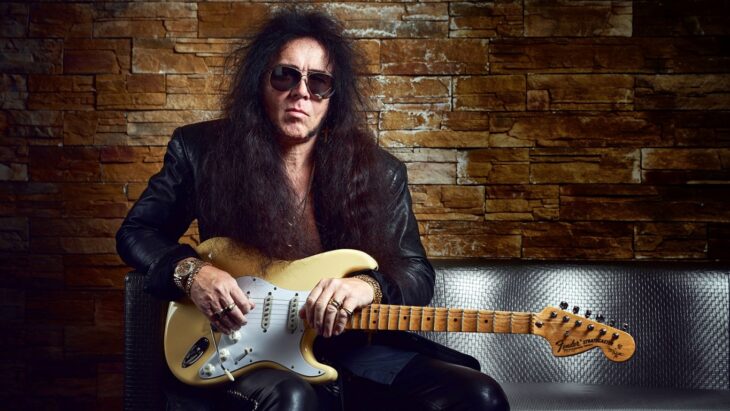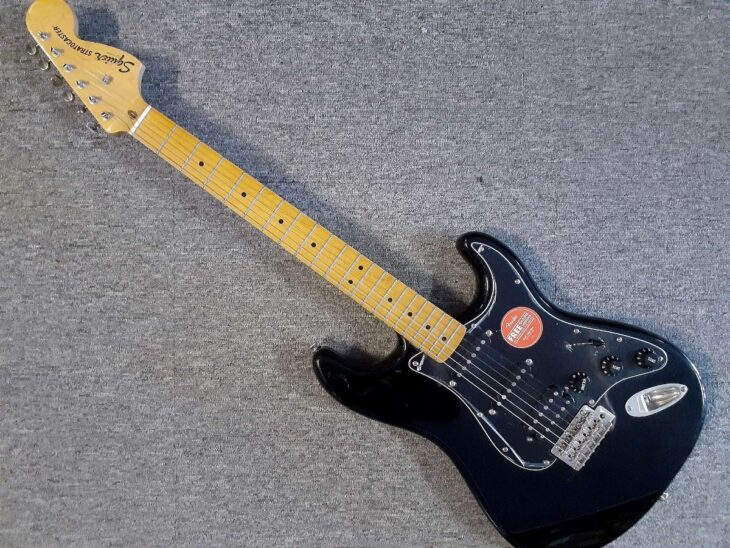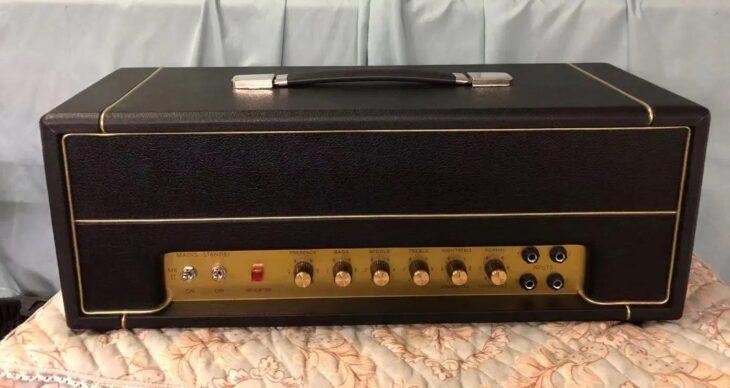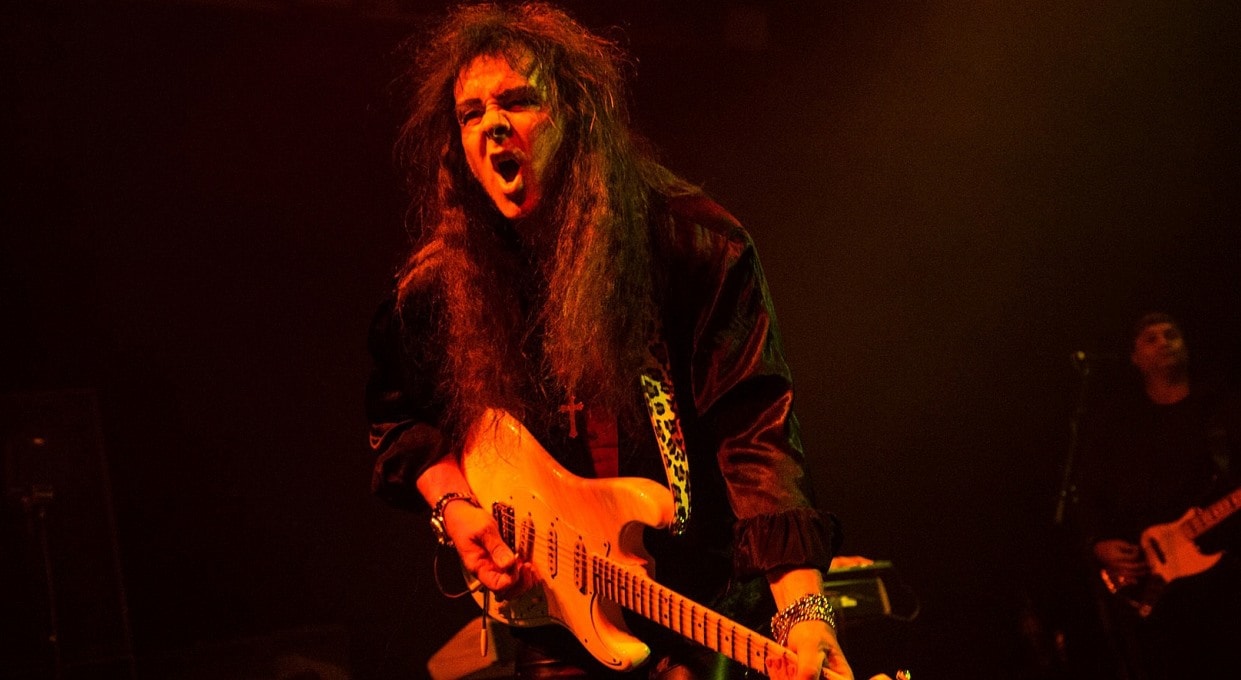Rising Force (1984) is more than just Yngwie’s debut album; it’s a statement. Yes, there’s a before and an after in the shredding world. In his introduction card, Yngwie didn’t just write his name, but he wrote history to come. After him, a myriad of fanatics, shredders, and virtuosos found an inspiration, a path, and a friend.
Today, four decades later, the man is still on the road, touring, and showing all the neo-classical distorted virtuosity that made him the legend he is today.
Beware, because you’re about to enter a world of fast cars, classical music, loud guitars, and a wall of Marshall amps that continues to rock crowds by the thousands in every corner of the planet.
Do you want to sound like Yngwie? Then read on, because here’s the recipe for it.
Table of Contents
Yngwie Malmsteen Guitars

We all know guitarists like Jimmy Page or Slash are Les Paul guys. Well, Yngwie arrived in the United States carrying one guitar. That guitar was a white Fender Stratocaster. You won’t likely see any picture of this shredmaster holding any other guitar model.
Moreover, together with Eric Clapton, Yngwie had the first Fender Stratocaster signature model ever made, released in 1988. These were tough times for the F giants since super Strats and humbucker-equipped guitars were ruling the scene by the end of the ‘80s.
But what’s special about Yngwie’s 1972 original blonde Stratocaster named “Duck” or simply “Play Loud”?
Let me detail it:
- Scalloped Maple Fretboard – Have you ever played a scalloped fretboard? Well, it’s as close as a guitar player can get to walking on air. A scalloped fretboard is when the fretboard portion between the frets is taken away, carved out. Thus, as you play, you don’t have any fretboard friction and your playing becomes faster. Let me tell you that I tried several of them, and despite having a steep learning curve, it feels like driving one of Yngwie’s Ferraris once you get used to it.
- Brass Nut – There is something about brass nuts that adds some brightness and sustain to whatever is being played.The resonance with the material brings out different tonal qualities. Plus, I think it looks cool too.
- YJM Fury Stacked Pickups – Seymour Duncan and Yngwie designed these pickups together. These aren’t just regular single-coil pickups, they have stacked coils so they’re completely silent but retain the edge and treble from single-coil, Strat-approved pickups.
- Bullet Truss Rod – You’re not playing through a true ‘70s Fender unless you have the famous bullet for truss rod adjustment. This makes it easier to get the guitar perfectly in shape in a matter of minutes.
- Super Jumbo Frets – The first time I picked up Yngwie’s signature guitar I was amazed by the size of the frets. It’s unbelievable just how tall and thick they are. That said, once you start speeding up your playing, the combination of the frets and the scalloped fretboard turns you into a shredder instantly.
Other than the qualities described above, his signature guitar also sports a 3-way pickup selector, a 9.5” radius, a vintage tremolo system, and a no-load tone pot for the middle and bridge pickup.
What is a no-load tone pot? Glad you asked; it’s a regular tone pot from 1 to 9 but when you move it from 9 to 10, it engages a true bypass system. As a result, the pot and its capacitor are removed completely from the circuit.
Now, if you want to acquire the real thing, you can opt between three guitars:
Former Fender Master Builder John Cruz made an exact replica of the instrument (including the biting that took place on the upper bout) and released a very short run of tribute guitars.
I had the privilege to interview John Cruz back then and let me tell you a little gossip. John told me he had to create a special tool to replicate Yngwie’s teeth and pay a plane ticket to take the guitar from and to the shred maestro’s house.
Although that’s the closest you can get to Yngwie’s real guitar, that’s a very hard instrument to acquire (at an astronomical price, too).
The next best thing is Fender’s Custom Shop version of the YJM Strat. If that’s a little too pricey for you still, you can get a regular Fender Artist Series YJM production model.
If you want a more affordable option, the Fender Vintera II ’70s Stratocaster is a very good guitar as well. You might want to add the Seymour Duncan YJM Fury pickups and have it scalloped.
Finally, although it comes with an HSS configuration, the Squier Classic Vibe ’70s Stratocaster is another great candidate to practice those harmonic minor and natural scales on.

Oh, and don’t forget about the custom Fender Yngwie Malmsteen Signature Electric Guitar Strings. They go from .008 to .046.
Yngwie Malmsteen Pedals
Yngwie’s main assets tone-wise are his hands and fingers. Nobody on Earth sounds like him, that’s why he continues raising fury and receiving ovations everywhere he goes.
But the man has also been sculpting his tone for the past four decades, and during that long and amazing ride, he picked up some toys.
Let me break down for you the pedalboard that Yngwie uses to achieve his main sounds.
First, let’s talk about distortion and overdrive. He’s widely known for using the legendary DOD 250 Overdrive Preamp pedal. Yet, nowadays he swapped that one for his (discontinued) signature Fender version (which he uses with both controls on 10).
Next, you absolutely need a Boss NS-2 Noise Suppressor to keep the noise from the high-gain rig down.
For some effects and 3-D-like stuff, Yngwie relies on a Boss DD-3 Digital Delay and a Boss CE-5 Chorus Ensemble. That odd factor is completed with a Boss RE-202 Space Echo, the recreation of Roland’s quintessential Space Echo unit.
For the signal to stay pristine clean and pumping loud as he plays clean, YJM trusts an MXR Dyna Comp.

Finally, the rig is completed with a Cry Baby Wah and a Whammy V locked in the octave-up setting.
To control all of this without tap dancing all night long, the shredmaster works with a Boss ES-8 Effects Switching System.
As a fun fact, Yngwie always carries a Jim Dunlop Fuzz Face but leaves it disconnected next to his pedalboard because he thinks it looks cool.
Yngwie Malmsteen Amplifiers
As much as Yngwie is a Strat guy, he’s also a Marshall guy. He has been playing Marshall from the beginning and continues to do so four decades later.
YJM’s first approach to Marshall was with the JMP heads, what is now the Marshall 1959HW.

This 100-watt all-tube beast requires volume to create overdrive and distortion, you can get a Marshall 1987X or a Marshall SV20H Studio Vintage to recreate his sound at a lower level.
The man himself plays through a wall of Marshall that often has 50+ heads and, at least, 30+ Marshall 1960AX and 1960BX 4×12 cabinets.
Although there’s a Marshall signature YJM 100-watt head, it has been discontinued, and it is very difficult to find one today.
https://www.youtube.com/watch?v=iD5MKYOqcC0&t=3s&ab_channel=MarshallAmplification
Yngwie Malmsteen Amp Settings
There’s a characteristic about old 1959 SLP or 1959HW heads as Marshall calls them now. This particularity is that EQ is subtractive, which means, in layman’s terms, that anything below 10 is taking away from the sound. In other words, everything on 10 means everything on 0.
Needless to say, the shredmaster uses “everything dimed”, which means everything on 10.
I’m going to give you a setting example so you can dial in Yngwie’s tone using other amplifiers that don’t share this subtractive characteristic in the EQ.
- Volume – 10
- Gain – 10
- Bass – 5
- Middle – 5
- Treble – 6
- Presence – 4
The Bottom End
Yngwie Malmsteen is not just a guitar virtuoso or a shred master, he’s a dreamer who carved his own niche in the music industry founding a style that was aligned with the way he plays and feels. He’s the first neoclassical shredder and one of the world’s finest guitar players.
This data above will get you close to his sound, all you need now is hours of practice and some Paganini fanaticism to nail the tone in his hands. After all, he made Rising Force at age 21!
Happy (neoclassical) playing!

